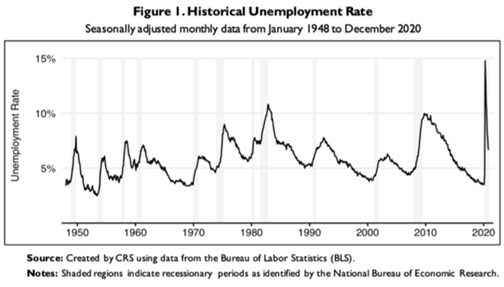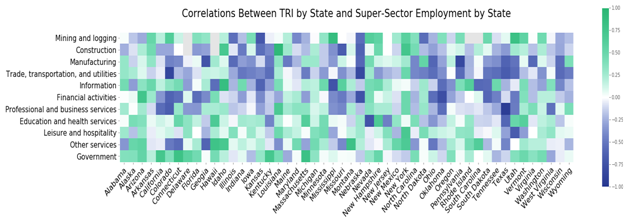Employment in the Pandemic: Through the Lens of Disease Transmission Risk Analytics
Co-Authored By: Ajay K Gupta, CISSP, MBA, CEO, HSR.health & John Etherton, Public Health Analyst, HSR.health
In Spring 2020, businesses all around the world were forced to shut down physical operations as a result of the COVID-19 pandemic. This has dramatically changed the way individuals and businesses operate.
The abrupt economic halt was a shock to the United States (US) and global economy, with April 2020 being a particularly historic month. Government-issued lockdowns and stay-at-home orders caused the unemployment rate to peak to an unprecedented 14.8%, which had not been observed since unemployment data collection began in 1948. Additionally, COVID-19 related unemployment rates in every state and the District of Columbia surpassed the highest unemployment rates of the Great Recession, leaving approximately 23.1 million individuals unemployed and fearing the unknown.

While every industry was impacted by the COVID-19 pandemic, some were affected more than others. The hospitality and leisure industry took a massive hit. Individuals were no longer able to go on amusement park trips, gather for dinner at restaurants with friends, or attend their favorite baseball game. The lack of business caused this industry’s unemployment rate to soar to 39.3% in April 2020.
On the other end of the spectrum, growing apprehension surrounding the safety of grocery stores, shopping malls, and other places of public gathering led many individuals to opt for delivery services such as InstaCart, Amazon, DoorDash, and UberEats during the pandemic. This has led to a substantial increase in the workforce and economic activity within the Couriers and Messengers sector. We have conducted an analysis to determine the relationship between and understand COVID-19’s impact on economic activity and sector-specific employment.
Read Also: Jifflenow Closes $11.9 Million Funding To Supercharge How Enterprises Book…
Employment through the Lens of Disease Transmission Risk: The Model and Exploratory Analysis
We aim to quantify the relationship between COVID-19 dynamics and economic outcomes on both the national and local scale as seen through employment levels. The end goal is to guide investment decisions based on health risks. Leveraging its Transmission Risk Index (TRI), we are able to analyze how COVID-19 influenced sector-level employment, shown below for Florida, Illinois, and California (Figure 2).
 Figure 2. Comparison of average weekly hours worked by employees and state-level TRI in (l to r) Florida, Illinois, and California.
Figure 2. Comparison of average weekly hours worked by employees and state-level TRI in (l to r) Florida, Illinois, and California.
Correlations were found in all three states, revealing underlying relationships between employment and COVID-19 spread dynamics. Notably, we found that as COVID-19 cases increased, employment and average weekly hours worked in the Couriers and Messengers sector also increased. The degree to which employment remains elevated, with respect to overall COVID-19 risks (considering case counts, hospitalizations, and death rates) may indicate the future share of retail activity between curbside pickup /delivery services and brick-and-mortar services, between delivery/take-out and dine-in. This effort can assess the degree to which consumers are resuming pre-pandemic behavior, which will indicate future activity and growth prospects for this sector.
Recommended: Will On-Premises Software Topple The Cloud Market In 2021?
Formalizing the relationship between disease transmission risk and industry or sector-wide economic activity through employment levels allows for an Employment Risk Index that can be leveraged to support investment decisions. We developed a data pipeline streamlining and expanding this analysis leveraging the TRI against all other industries. The pipeline extracts data from the Bureau of Labor Statistics (BLS) for analysis and comparison against state-level TRI, or alternately any other pandemic risk indices.
 Figure 3. Correlation Between State Transmission Risk Index and State Level Super-Sector Employment
Figure 3. Correlation Between State Transmission Risk Index and State Level Super-Sector Employment
Similar to the Couriers and Messengers, other industries’ employment and economic outcomes have had a strong relationship with the transmission of COVID. Beyond a basic exploratory analysis, predictive machine learning techniques are leveraged to understand the future implications behind the pandemic recovery.
 Understanding the risks from any factor that changes the health posture of a population can help inform strategic investment and business decisions. Such analysis can help industries anticipate and take advantage of health-related risks to operations.
Understanding the risks from any factor that changes the health posture of a population can help inform strategic investment and business decisions. Such analysis can help industries anticipate and take advantage of health-related risks to operations.

Comments are closed.